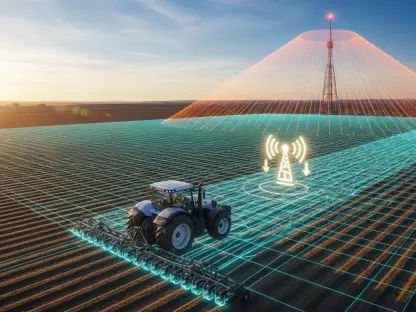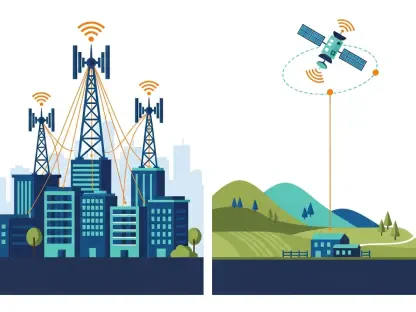Evolving mobile network security presents a dynamic landscape filled with challenges and innovations. Alex Leadbeater, Technical Security Director at the GSMA, sheds light on the current and future state of mobile network security, emphasizing the importance of collaboration and continuous adaptation.
Transforming the Security Landscape
From Initial Development to Digital Backbone
Mobile networks have evolved significantly from rudimentary systems to becoming the core of modern digital infrastructure, enabling global connectivity and driving technological innovation. This transformation has not only enhanced functionality and efficiency but also introduced a myriad of complexities that fundamentally alter the security landscape. With the inception of new advancements like 5G networks, the importance of implementing robust security measures has become paramount. Mobile networks, once simple communication channels, now interconnect diverse technologies, services, and applications, which demand rigorous security protocols to safeguard sensitive data and ensure uninterrupted service.
The transition from early mobile systems to sophisticated networks underlines a profound change; the growing complexity brings about new vulnerabilities and threats. This requires a continuously evolving security framework capable of adapting to new challenges. As dependency on mobile networks increases, the integral nature of security becomes more pronounced, necessitating a comprehensive approach that includes both proactive and reactive measures to effectively address potential risks. The need for ongoing development and refinement of security strategies to counteract an ever-expanding array of threats is imperative for maintaining the integrity and reliability of mobile networks.
Legacy Systems and Modern Networks
Despite the advancements in mobile network security, legacy systems continue to pose significant challenges. Technologies like SS7, designed in an era of lesser security concerns, are particularly vulnerable when integrated with modern networks. These systems, often deeply embedded in critical infrastructure, provide entry points for potential attacks, complicating the overall security framework. While new greenfield 5G networks offer improved security, the necessity to interface with older systems means vulnerabilities persist. The challenge of securing such hybrid environments underscores the importance of addressing inherent weaknesses in legacy technologies.
Phasing out these legacy systems is a formidable task, especially given their pervasive use in essential services like smart meters. Leadbeater underscores that the process of integrating modern security features into older systems is complex and resource-intensive. However, the continuous reliance on these outdated technologies makes it imperative to innovate security measures specifically tailored to safeguard them. The dual necessity of maintaining functional legacy systems while ensuring they do not compromise the security of newer networks highlights the ongoing tension between technological innovation and security.
Emerging Technologies and Integrated Security
Security in Greenfield 5G Networks
Leadbeater recognizes that new greenfield 5G networks, being built from the ground up with modern security considerations, generally exhibit robust security features. These networks are designed with end-to-end encryption, multi-layered security protocols, and enhanced authentication mechanisms that fundamentally mitigate numerous threats. However, security challenges arise when these advanced networks must interact with legacy systems. The integration of these disparate network components creates potential vulnerabilities, as older technologies were not initially designed to meet contemporary security standards.
The critical connectivity provided by 5G, vital for services like smart meters and other IoT devices, faces the risk of being undermined by older technologies. Ensuring that greenfield networks retain their inherent security advantages requires rigorous risk assessment and the implementation of stringent security frameworks. This encompasses not only protecting the network architecture but also ensuring that any connection points between old and new technologies are robustly secured. The commitment to continuous improvement and adaptation of these security strategies is essential to maintain the integrity and resilience of mobile networks amid evolving threats.
Expanding Attack Surface with New Technologies
The advent of technologies such as Open RAN and network APIs significantly expands the mobile network attack surface, introducing new vectors for potential threats. These innovations, while offering greater flexibility, scalability, and interoperability, also bring with them increased complexity. Each new technology or feature adds potential ingress points for malicious activities, despite the inherent security measures incorporated within their design. The ongoing expansion of network capabilities, while positive for technological advancement, also means that security strategies must continuously adapt to encompass these new elements.
Implementation nuances play a critical role in determining the effectiveness of these security systems. Although foundational security principles remain pertinent, proper deployment and configuration are critical to harness their full protective potential. Technologies like Open RAN, which enable greater adaptability and vendor diversity, can ensure robust security if meticulously implemented. However, improper application of these technologies can inadvertently introduce weaknesses. Thus, maintaining a vigilant approach toward the deployment and operationalization of these new technologies is crucial to address the expanding attack surface effectively.
Implementing Robust Security Strategies
Proper Deployment Over Design
While foundational security principles remain essential, the efficacy of technologies such as Open RAN and network APIs largely depends on their implementation rather than their mere design. Even the most robust security features can fail if improperly deployed. Ensuring that implementation follows stringent guidelines and best practices can significantly enhance overall network security. Proper deployment encompasses understanding the intricacies of how these technologies interact within the broader network environment and addressing potential vulnerabilities at every stage of integration.
This aspect of security strategy emphasizes the necessity for thorough planning, testing, and continuous monitoring of new technologies. Training and development of personnel to handle these sophisticated systems effectively also play a crucial part. As the landscape of telecommunications technology evolves, maintaining a high standard of deployment practices ensures that security measures are not only state-of-the-art but are also applied correctly to mitigate risks and vulnerabilities. This proactive approach helps to sustain the integrity and resilience of mobile networks in an increasingly complex digital environment.
Defensive Force Multipliers
Industry-wide collaboration through platforms like T-ISAC significantly enhances the ability to share threat intelligence and bolster defensive capabilities. Leadbeater highlights the critical role of collaborative efforts in improving security strategies across the telecommunications sector. By pooling resources and sharing real-time threat information, approximately 120 GSMA members can collectively enhance their threat detection and response strategies. This shared defense mechanism acts as a “defensive force multiplier,” enabling a stronger, more unified approach to tackling emerging threats.
The effectiveness of T-ISAC and similar initiatives lies in their ability to facilitate instant communication and coordinated responses among diverse stakeholders. The retrospective analysis of threats, such as the FluBot malware outbreak, exemplifies the advantages of these collaborative efforts. By proactively identifying and addressing emerging trends before they become widespread threats, the telecommunications industry can maintain a dynamic and adaptive security posture. This collaborative approach underscores the importance of unity and shared knowledge in enhancing the overall security framework of mobile networks.
Proactive Threat Detection and Supply Chain Security
Enhancing Threat Detection
The GSMA’s Mobile Telecommunications Security Landscape report underscores the importance of proactive threat detection in modern mobile network security. The success of collaborative efforts in identifying and mitigating threats before they escalate is a testament to the importance of collective intelligence. The FluBot malware outbreak provides a prime example; by analyzing historical threat data and identifying patterns, operators can preemptively address vulnerabilities. This proactive stance is critical in a landscape where threats are continuously evolving and becoming more sophisticated.
Real-time threat intelligence and advanced analytics play pivotal roles in enhancing detection capabilities. By leveraging collaborative platforms, operators can share insights and strategies that improve overall resilience against cyber threats. Moreover, ongoing research and development efforts to refine threat detection methodologies ensure that mobile networks remain ahead of potential attackers. This persistent and forward-thinking approach to security reflects the industry’s commitment to protecting critical infrastructure and ensuring the safe operation of mobile networks in the face of growing threats.
Dealing with Supply Chain Resilience
In light of recent disruptions, there’s an increasing emphasis on enhancing supply chain resilience. This involves not only diversifying suppliers but also investing in advanced technologies to predict and mitigate potential interruptions. As global trade continues to evolve, companies must adopt more robust strategies to ensure the smooth flow of goods and services.
Supply chain resilience is a crucial aspect of mobile network security, especially given the global nature of telecommunications technology. Leadbeater advocates for a thorough understanding of one’s network and supply chain to mitigate risks effectively. Reducing dependency on a single supplier and diversifying procurement strategies are fundamental tactics to enhance resilience. The importance of tools like Software Bill of Materials (SBOM) and the GSMA’s Network Equipment Security Assurance Scheme (NESAS) is crucial in this context, as they provide detailed insights into the security practices and integrity of suppliers.
The challenges experienced during the COVID-19 pandemic highlighted the vulnerabilities of uniform supplier choices and underscored the need for a diversified strategy. A balanced approach that includes rigorous vetting and continuous monitoring of suppliers can significantly reduce risk exposure. Understanding supplier dependencies and potential points of failure within the supply chain facilitates the development of robust contingency plans. This comprehensive strategy ensures that mobile networks remain resilient and secure even amid disruptions, thereby safeguarding critical infrastructure.
Global Interdependence and Adaptability
Addressing Geopolitical and Natural Disruptions
The global nature of telecommunications technology necessitates resilient security strategies that account for various disruptions, including geopolitical tensions and natural disasters. Leadbeater emphasizes the importance of developing adaptive security measures that sustain service continuity irrespective of external variances. This approach includes planning for scenarios where international supply chains may be disrupted, ensuring that alternative sources and backup solutions are readily available.
Geopolitical factors can have profound implications on the availability and security of telecommunications infrastructure. By adopting a resilient strategy, operators can mitigate risks associated with fluctuating geopolitical landscapes and maintain operational continuity. Similarly, preparing for natural disruptions involves proactive measures to reinforce physical infrastructure and ensure redundancy. The interplay between these factors demands a comprehensive security strategy that is both dynamic and robust, capable of adapting to unforeseen challenges while maintaining the integrity and reliability of mobile networks.
Evolving Threats and Continuous Vigilance
Continuous vigilance is paramount in dealing with the transient nature of security threats. Leadbeater underscores that what is considered secure today may not be secure tomorrow, necessitating an ongoing commitment to proactive security measures. This dynamic approach involves regular updates, continuous monitoring, and immediate responses to emerging vulnerabilities. The cybersecurity landscape is characterized by rapid evolution, and staying ahead of potential threats requires adaptability and foresight.
Proactive security measures involve not only technological solutions but also comprehensive training and awareness programs for personnel. By fostering a culture of security within the organization, operators can ensure that all stakeholders are equipped with the knowledge and skills to recognize and respond to threats effectively. This holistic approach to security emphasizes the importance of continuous learning, adaptation, and vigilance in maintaining the integrity of mobile networks. Understanding that security is an evolving practice ensures that operators remain prepared to counteract emerging threats and protect critical infrastructure.
Balancing Privacy and Security
Privacy Regulations Impact on Threat Detection
Privacy regulations, particularly in Europe, present additional challenges for threat detection within mobile networks. Regional disparities in privacy laws restrict the analysis of communication content, limiting the ability to detect breaches and potential security threats. These regulations, designed to protect individual privacy rights, necessitate a careful balance between security and privacy. Effective threat detection methodologies must navigate these regulatory frameworks while ensuring that security measures are not compromised.
Operators must develop strategies that respect privacy directives while implementing robust security measures. This involves leveraging advanced technologies that can detect anomalies without infringing on privacy rights. Data anonymization and encryption techniques, combined with behavioral analysis, can provide valuable insights while adhering to regulatory requirements. The challenge lies in creating security solutions that are both effective and compliant, ensuring that privacy protections are maintained alongside robust threat detection capabilities.
Addressing Human Factors
Human factors remain one of the most significant vulnerabilities in mobile network security. Human errors, such as clicking on malicious links or falling for phishing schemes, consistently contribute to security breaches. Ongoing education and awareness campaigns are critical in mitigating these risks. By equipping users with the knowledge and skills to recognize potential threats, operators can significantly reduce the impact of human error on network security.
Training programs should focus on practical scenarios and provide clear guidelines for identifying and responding to security threats. Additionally, fostering a culture of security within organizations, where employees are encouraged to report suspicious activities without fear of retribution, can enhance the overall security posture. Behavioral training, combined with regular updates and refreshers, ensures that individuals remain vigilant and informed about the latest threats. Addressing the human element is a crucial component of a comprehensive security strategy, as it reinforces the technological measures in place.
Future Outlook on 6G Technology
Integrating Secure APIs and AI
As 6G technology begins to take shape, early security considerations focus on integrating secure APIs and ensuring the robustness of AI systems. These advancements promise to enhance network capabilities by automating processes and enabling more sophisticated interactions. However, with increased complexity comes an elevated risk profile. Ensuring these elements are secure from the onset is paramount. Secure API integration involves implementing strict access controls, comprehensive auditing, and encryption to prevent unauthorized access and data breaches.
AI robustness is equally critical. Advanced AI systems can autonomously detect and mitigate threats, streamlining security operations. However, ensuring the integrity of these systems requires rigorous testing and validation to safeguard against manipulation and exploitation. 6G technology envisions enhanced connectivity and lower latency, integrating more closely with satellite communications and other technologies. Addressing security at the developmental phase ensures that these advanced capabilities do not introduce new vulnerabilities and that they integrate seamlessly within the secure framework of the existing network infrastructure.
The SEC’s Cautious Approach and Call for Public Comment
In its deliberate approach to addressing the complexities of cryptocurrencies, the SEC opted for another delay in its verdict on the spot Ethereum ETF. The extension grants the SEC an opportunity not only to conduct an in-depth examination of Ethereum’s suitability for ETF status but also to source public insight, which could heavily sway the conclusion. This speaks to the SEC’s attentiveness to the nuances of digital assets and their integration into regulatory frameworks, which it does not take lightly. The situation closely parallels the stalling faced by Grayscale, who is also waiting for the green light to transform its Ethereum Trust into a spot ETF, raising questions about the contrasting regulatory processes for Bitcoin and Ethereum.
Quantum Computing Threats
With the anticipated rise of quantum computing, new security challenges are emerging, particularly regarding cryptographic protocols. Leadbeater anticipates that 6G networks will integrate quantum-safe algorithms from the onset, designed by NIST, to counteract the advanced computational power of quantum systems. This forward-thinking approach aims to preemptively address potential threats before quantum computing becomes mainstream.
Quantum-safe algorithms offer robust protection against the immense processing abilities of quantum computers that could otherwise decrypt data easily. Incorporating these algorithms into the foundational design of 6G networks ensures long-term security and resilience. The adoption of quantum-safe cryptographic techniques represents a critical step in future-proofing mobile networks against evolving threats. This approach highlights the need for ongoing research and development to stay ahead of technological advancements and ensure that security frameworks are robust and adaptable to future innovations.
Collaboration for Defense Enhancement
GSMA’s Collaborative Initiatives
The GSMA’s commitment to enhancing mobile network security through collaboration is exemplified by its initiatives, such as expanding security content at industry forums like Mobile World Congress. These efforts foster a collective understanding and a unified approach to addressing evolving threats within the telecommunications industry. By facilitating dialogue and knowledge sharing among stakeholders, the GSMA promotes the development of comprehensive security standards that reflect the latest advancements and threats.
Initiatives like T-ISAC, the Fraud and Security Group (FASG), and continuous standards development represent the GSMA’s holistic approach to fortifying the industry’s defenses. Regular forums, workshops, and collaborative platforms enable operators to stay informed about the latest threats and security techniques. This community-driven effort ensures that all stakeholders are equipped with the tools and knowledge to combat emerging security challenges effectively. The GSMA’s initiatives underscore the importance of collaborative strategies in enhancing mobile network security, fostering a proactive and resilient industry-wide defense posture.
Industry-wide Threat Intelligence Sharing
Mobile network security is continually evolving, bringing forth a dynamic landscape of both challenges and innovations. Alex Leadbeater, the Technical Security Director at the GSMA, offers his insights into the current and future state of mobile network security. He highlights the critical need for robust collaboration and a willingness to adapt continuously in order to stay ahead of emerging threats. According to Leadbeater, mobile networks are facing increasingly sophisticated attacks that require industry-wide cooperation and the adoption of cutting-edge security measures. He emphasizes that as technology advances, so too must the strategies for protecting network infrastructure. Constant vigilance and innovation are key to mitigating risks and ensuring the seamless operation of mobile networks. Leadbeater’s insights underscore the importance of staying proactive and fostering a collaborative mindset to effectively address the complexities of mobile network security.









